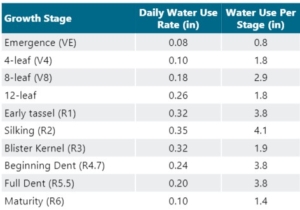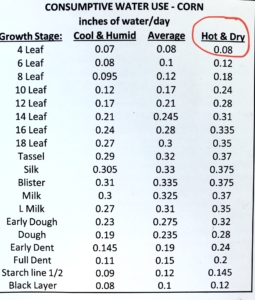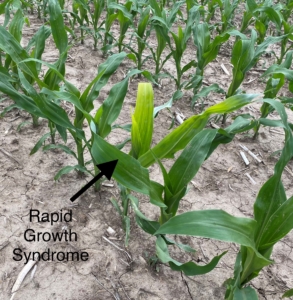Fun Fact: It takes 91 gallons of water to produce one pound of corn….that’s roughly 5,000 gallons per bushel!
TOPICS FOR THIS UPDATE:
- Temperatures/Precipitation & GDU accumulation
- What’s going on in my fields right now….ET rates, silking, etc.
- Disease Update & Fungicides….
- Insect Update
- Soybean Update
TEMPERATURES & GDU ACCUMULATION:
As of June 27th, we have accumulated approximately the following for Growing Degree Units in 2023:
Planting Date GDD’s2022 Average GDD Departure from average
April 17 1130 1036 +94 (+4.5 days)
April 26 1086 977 +109 (+5 days)
May 9 955 868 +87 (+4 days)
The crop is still running ahead of normal, but we have lost 4 days from the last update on June 9th (we were 7-8 days ahead then). Average GDU accumulation since the last update has been 20-21 GDU’s/day which is the average. From the below forecast maps, it appears that this trend will continue over the next 10 days or so.




The above maps are forecasts for temperature and precipitation for the next 6-10 and 8-14 days. As you can see, temperatures are expected to be average-to-possibly slightly-below average. This will mean less stress on the crop but will push the silk dates further into July. It is nice to see the precip maps show ‘green’ for our area. We have a decent chance to see much needed rainfall over the next 10-14 days. However, this time of year rain usually comes with storms….
What’s Going On In My Fields Right Now?….and What’s Next?….
- Much of the corn crop is in the 10-13 leaf stage right now.
- At this stage, the tassel is beginning to develop rapidly now and the stalk is continuing rapid elongation. Still too early to tell overall plant height, but we are expecting taller than last year….
- Stalk elongation occurs through the elongation of its internodes. Next few weeks will see peak susceptibility to green snap….
- By V10, the time between the appearance of new leaf stages will shorten, generally occurring every two or three days…or approximately a leaf for every 50 GDU’s.
- Current forecasts predict we will be accumulating 22-26 GDU’s/day, so expect a new leaf potentially every couple of days.
- At V10, the corn plant begins a rapid, steady increase in nutrient and dry weight accumulation which will continue far into the reproductive stages.
- Soil nutrients and water are now in greater demand to meet the needs of this increased growth rate. Keep this in mind as you think about your total N applied so far and what future needs will be….and keep in mind a post-pollination application in your N plans….
- Kernels per row begin around V12 and continue through and up to tassel stage….so starting right now and over the next couple of weeks….
- Overall color and N efficiency has been very good so far this year, especially on sandier soils…..one benefit from the dry conditions. There has been limited N leaching, while N mineralization should be good this year if temperatures stay on the warm side.
- Greatest yield loss from moisture stress occurs from two weeks prior to, to two weeks after tassel. With current weather conditions and forecasts, the great majority of the crop will most likely be tasseling around July 10-18th. This will depend upon temperatures, hybrid and planting date of course. GDU’s to silk run from 1280 – 1450 depending upon hybrid. If forecasts turn out to be true, GDU accumulation over the next two weeks will be approximately 380 GDU’s….add this to 1000 and we will reach 1300-1400 GDU’s by July 12th…..In other words we should start to see tassels in 10-14 days depending upon hybrid and planting date. We could possibly see a few tassels just after the 4th of July on the first planted fields with an early-silking hybrid. Bottom line, water needs will be greatest over the next month and into early August.
- ET rates in corn are still running on the high side. From June 14-27th, ET rates have averaged .27″/day, or 3.8″ total….this is almost the normal rainfall total we receive in June! So far we are short 6″ of rain for the year in our area which June short 2.5″. The moisture probes in the area are still showing heavy ‘pull’ over the past two weeks. Current rooting depth is 24-32″ in the majority of the clay soils and 16-24″ in the sandy soils. The crop is starting to increase it’s ‘pull’ from the 2nd foot of profile now, so maintaining an adequate soil moisture profile in the top 2′ will be key over the next few weeks heading into pollination which is peak crop water usage. If the above maps are wrong and we miss the moisture, it will be increasing difficult to stay ahead on irrigation, so make sure you are ahead of the curve over the next two weeks and beyond. Keep praying for rain….
- The main nodal root system is developing with the last (5th) nodal root developing quickly now. Brace roots will develop over the next couple of weeks.
- Waterhemp and Palmer Amaranth control continues to be a constant battle in both corn and soybeans….and sometimes I think the weeds win! Each year we continue to see the need for increased rates of growth-regulators, etc. For best control, Palmer has to be sprayed when it’s small…anything over 4″ and potential for re-growth goes up. We know cultivating is a ‘four-letter’ word, but it still has its place as the below pictures attest to….
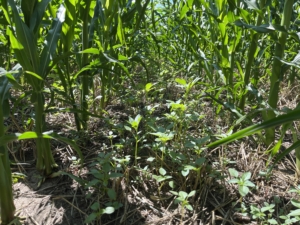
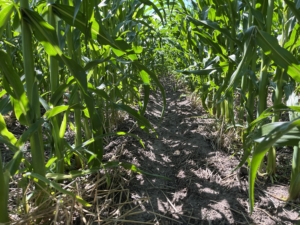
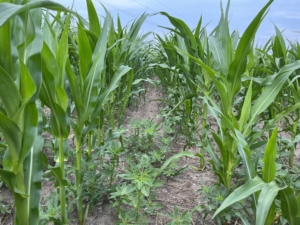
- These first two pictures show a side-by-side of cultivated vs. not-cultivate end rows. In the third picture you can see the difference between where the cultivator was raised for a pivot road and then lowered again…the background of the row is clean….
DISEASE UPDATE & FUNGICIDES….CORN & SOYBEANS….
- Leaf disease pressure, in corn and soybeans both, is very low at the present time. Bacterial Leaf Streak is showing up in many fields, but low incidence yet. We have seen a few Northern Corn Leaf Blight lesions start to appear, which is unusual to see this early. Disease pressure will increase if we receive more moisture and temperatures are moderate.
- We have seen good responses to fungicide applications in both corn and soybeans over the past few years, and we recommend a fungicide application on both crops. Timing is best for corn right after pollination….7 days after you see the corn field fully tasseled, pollination is pretty well complete. This is when the plant is working the hardest, so this is when you want the most protection. Soybean applications depend upon whether you are controlling for white mold or not. Any fungicide application for white mold should be going on now, or next week. To get best results on controlling white mold, one needs to treat at R1 (Beg. flower) for sure. Most soybean fields are at 7 trifoliate-to-R1 or late-R1. If not controlling for white mold, the best timing is at R3, or pod set. If spraying for white mold, Aproach and Delaro give the best protection!
INSECT UPDATE….
- We are currently finding 0-12% European Corn Borer larvae infestations in popcorn. Keep an eye out on your popcorn and conventional corn acres for this pest. We are getting good results from treating. Larvae are very small at present
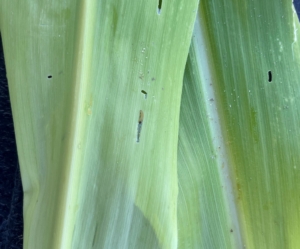 and treatments should be going on this week into next for best control. Moths are still flying, so continue to monitor for this pest over the next week or so.
and treatments should be going on this week into next for best control. Moths are still flying, so continue to monitor for this pest over the next week or so. - Plan on scouting just prior to tasseling for Western Bean Cutworm, start checking end of next week. We will have pheromone traps out once again to monitor flight activity.
- So far very little insect activity in soybeans. Just seeing a few Thistle caterpillars….
- Starting to see small grasshoppers
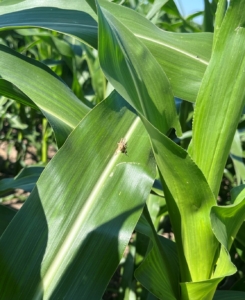 show up in corn and soybeans. Keep an eye out for this pest due to the dry, hot conditions. They are very thick in grass corners and rye crop. They are starting to defoliate in both crops. The smaller they are, the easier they are to control.
show up in corn and soybeans. Keep an eye out for this pest due to the dry, hot conditions. They are very thick in grass corners and rye crop. They are starting to defoliate in both crops. The smaller they are, the easier they are to control. - Corn rootworm larvae are in the 2nd-3rd instar stage to at present. Begin scouting for adults as tassels and silks begin to show up to protect from any silk-clipping interfering with pollination and to help determine timing of adult beetle control for next year on the corn-on-corn acre.
SOYBEAN UPDATE
- Soybeans are currently in the late vegetative-to-R1 (Beg. flower) stage.
- Soybeans have finally started to grow over the past week or so.
- We have been seeing more iron chlorosis (yellow to pale green areas) start to appear on the high pH hillsides and low, sandy spots in area fields. This usually comes on when conditions turn wetter and cooler. However, the dry conditions seem to have exacerbated this condition for some reason. This is the highest incidence of this that we have seen for a number of years. In fact, those areas of the state that normally see this, are seeing the highest levels that they have experienced for many, many years.
- EnList E3 Update – The Enlist/Liberty herbicide tank-mix has looked very good so far. However, time will tell on whether every growing point of the Palmer was burned back or not and if we see any re-growth. Scout again in 2-3 weeks. This is the same for Enlist or Xtend programs..
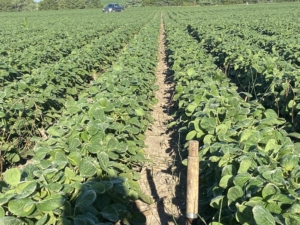
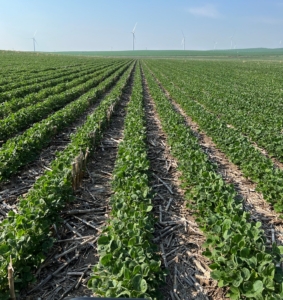 Enlist/Liberty Program….
Enlist/Liberty Program….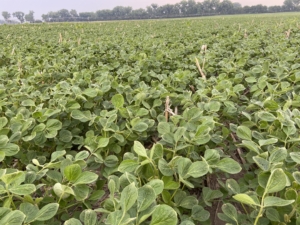
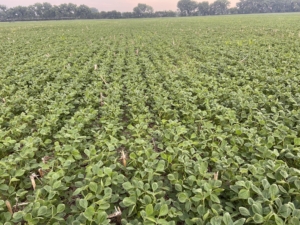 P25A16E almost fully canopied in 15″ rows.
P25A16E almost fully canopied in 15″ rows.- As one can see from the above photos, the cupping in Enlist soybeans is not the same everywhere…some fields are showing very little cupping….others are heavier.
As always, please let us know any questions or concerns you may have! Thank you for your support!
Starman Seed Service, Inc.

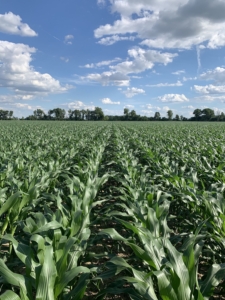
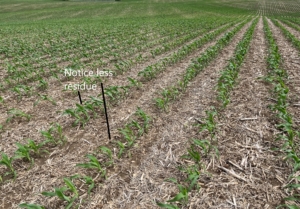
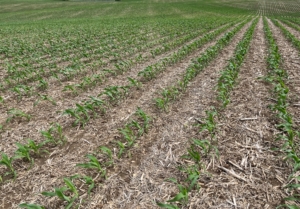
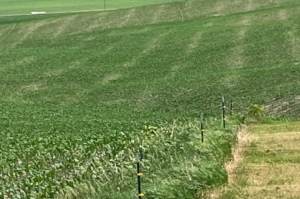

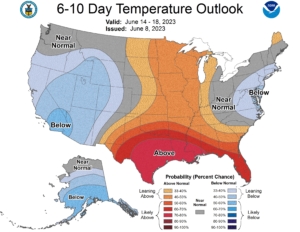
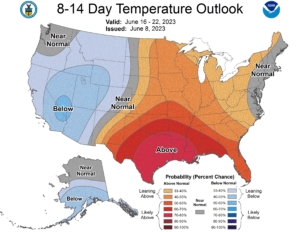
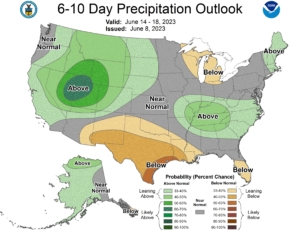
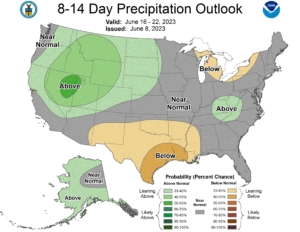
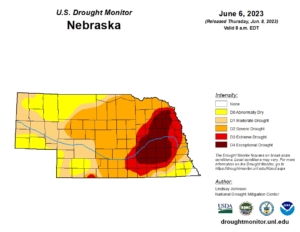
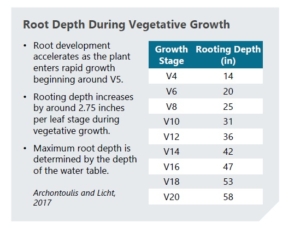 From the chart, you can see that average rooting depth for V6-V8 corn is approximately 20-25″, depending upon weather conditions, soil type and structure, etc. Currently the AquaSpy moisture probes are showing 12-24″ rooting depths across soil types and planting dates, so we are very much in the normal on rooting depth. However, soil moisture profile is low overall and it is now easier to pick out dryland corners, etc.
From the chart, you can see that average rooting depth for V6-V8 corn is approximately 20-25″, depending upon weather conditions, soil type and structure, etc. Currently the AquaSpy moisture probes are showing 12-24″ rooting depths across soil types and planting dates, so we are very much in the normal on rooting depth. However, soil moisture profile is low overall and it is now easier to pick out dryland corners, etc.